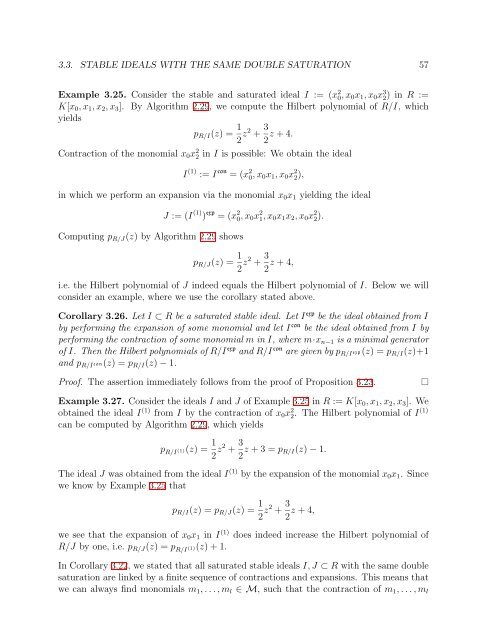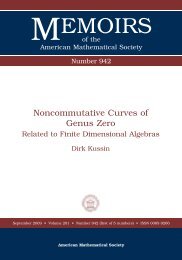University of Paderborn Department of Mathematics Diploma Thesis ...
University of Paderborn Department of Mathematics Diploma Thesis ...
University of Paderborn Department of Mathematics Diploma Thesis ...
Create successful ePaper yourself
Turn your PDF publications into a flip-book with our unique Google optimized e-Paper software.
3.3. STABLE IDEALS WITH THE SAME DOUBLE SATURATION 57Example 3.25. Consider the stable and saturated ideal I := (x 2 0, x 0 x 1 , x 0 x 3 2) in R :=K[x 0 , x 1 , x 2 , x 3 ]. By Algorithm 2.29, we compute the Hilbert polynomial <strong>of</strong> R/I, whichyieldsp R/I (z) = 1 2 z2 + 3 2 z + 4.Contraction <strong>of</strong> the monomial x 0 x 2 2 in I is possible: We obtain the idealI (1) := I con = (x 2 0, x 0 x 1 , x 0 x 2 2),in which we perform an expansion via the monomial x 0 x 1 yielding the idealComputing p R/J (z) by Algorithm 2.29 showsJ := (I (1) ) exp = (x 2 0, x 0 x 2 1, x 0 x 1 x 2 , x 0 x 2 2).p R/J (z) = 1 2 z2 + 3 2 z + 4,i.e. the Hilbert polynomial <strong>of</strong> J indeed equals the Hilbert polynomial <strong>of</strong> I. Below we willconsider an example, where we use the corollary stated above.Corollary 3.26. Let I ⊂ R be a saturated stable ideal. Let I exp be the ideal obtained from Iby performing the expansion <strong>of</strong> some monomial and let I con be the ideal obtained from I byperforming the contraction <strong>of</strong> some monomial m in I, where m·x n−1 is a minimal generator<strong>of</strong> I. Then the Hilbert polynomials <strong>of</strong> R/I exp and R/I con are given by p R/I exp(z) = p R/I (z)+1and p R/I con(z) = p R/I (z) − 1.Pro<strong>of</strong>. The assertion immediately follows from the pro<strong>of</strong> <strong>of</strong> Proposition 3.23.Example 3.27. Consider the ideals I and J <strong>of</strong> Example 3.25 in R := K[x 0 , x 1 , x 2 , x 3 ]. Weobtained the ideal I (1) from I by the contraction <strong>of</strong> x 0 x 2 2. The Hilbert polynomial <strong>of</strong> I (1)can be computed by Algorithm 2.29, which yieldsp R/I (1)(z) = 1 2 z2 + 3 2 z + 3 = p R/I(z) − 1.The ideal J was obtained from the ideal I (1) by the expansion <strong>of</strong> the monomial x 0 x 1 . Sincewe know by Example 3.25 thatp R/I (z) = p R/J (z) = 1 2 z2 + 3 2 z + 4,we see that the expansion <strong>of</strong> x 0 x 1 in I (1) does indeed increase the Hilbert polynomial <strong>of</strong>R/J by one, i.e. p R/J (z) = p R/I (1)(z) + 1.In Corollary 3.22, we stated that all saturated stable ideals I, J ⊂ R with the same doublesaturation are linked by a finite sequence <strong>of</strong> contractions and expansions. This means thatwe can always find monomials m 1 , . . . , m l ∈ M, such that the contraction <strong>of</strong> m 1 , . . . , m l
















